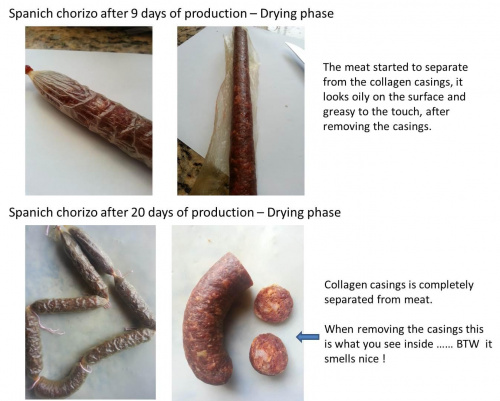Luis, the Spanish love to add vinegar or wine to their chorizo recipe. This is the ingredient that makes it unique. Howevery, these liquids unravel proteins like crazy! Because proteins have both acidic parts and basic parts, the acidity of the solution they are in changes their behavior. Acids release protons (hydrogen nuclei) and bases accept protons. In an acidic solution, the basic parts of the protein accept protons from the acidic solution and become positively charged. The positive charges
repel one another, and the protein molecules are
less likely to combine with one another.
In a basic solution, the acidic parts of the protein lose a proton, and become negatively charged. This also results in repulsion between the protein molecules, and combination is reduced. Charged areas of the protein interact with water molecules, because water is a polar molecule, with one end negative and one end positive. These charged ends are attracted to opposite charges on the protein.
Vinegar is one of the products of the grape. Acetic acid is the main component of vinegar. It also contains anthocyanins , flavonols , vitamins, mineral salts, amino acids and non-volatile organic acids such as tartaric, citric, malic, and lactic acids. Studies have demonstrated that grape juice
enhances the resistance to oxidative modification of low density lipoprotein (fat).
The tertiary structure of a protein is what we get when the protein folds into a three dimensional shape. There is an entire class of proteins called globulins because of their shape and often soluble proteins are globular or almost spherical in shape. Insoluble proteins like collagen in connective tissue, elastin in tendons and arteries, and keratins in hair, hooves, and nails, are forms of fibrous protein. Some proteins are combined with other molecules to form conjugated proteins. In the nuclei of cells, nucleic acids combine with proteins to form nucleoproteins. Combined with just a little carbohydrate a protein is called a
glycoprotein (from the word for sugar). Combined with more than about 4% carbohydrate, proteins are called
mucoproteins. And combined with fat, they are
lipoproteins.
These properties form what is called the quaternary structure of a protein. As you might guess from the name, there are four kinds of structure in proteins. In their natural state, proteins like egg albumin and milk casein are soluble in water. Most of their hydrogen bond forming parts are tucked inside the folded structure of the protein, making them unavailable for forming bonds with other molecules. They are all the same shape, so that they all have the same properties, and can form crystals.
There are several mechanisms that destroy these properties. Heat, acids, strong alkalis, alcohol, urea, salicylate, and ultraviolet light are among the more common ways that proteins become denatured. As denatured proteins unfold, many of the hydrogen bonds that preserve the three dimensional structure of the proteins are broken. Instead of a uniform solution of molecules that are all the same shape, in a denatured protein, the molecules can take on a limitless number of different shapes and they become water soluble.
In cooking, we control the denaturing of proteins in several ways. We can control the temperature, we can control the acidity, we can use copper bowls to beat the egg white and catalyze the formation of disulfide bonds in the proteins, and we can control the fat or air content when we beat the proteins. Holy crap, Luis.... did you get all of that?

Again, as stated above, because proteins have both acidic parts and basic parts, the acidity of the solution they are in changes their behavior.
Acids release protons (hydrogen nuclei) and
bases accept protons. In an acidic solution, the basic parts of the protein accept protons from the acidic solution and become positively charged.
The positive charges repel one another, and the protein molecules are less likely to combine with one another.
In a basic solution, the acidic parts of the protein lose a proton, and become negatively charged. This also results in repulsion between the protein molecules, and combination is reduced. Charged areas of the protein interact with water molecules, because water is a polar molecule, with one end negative and one end positive. These charged ends are attracted to opposite charges on the protein.
So..... blame the vinegar!

Best Wishes,
Chuckwagon






